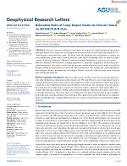Relaxation States of Large Impact Basins on Mercury Based on MESSENGER Data

Author
Szczech, Claudia
Broquet, Adrien
Plesa, Ana-Catalina
Publication date
2024Published in
Geophysical Research LettersVolume / Issue
51 (22)ISBN / ISSN
ISSN: 0094-8276ISBN / ISSN
eISSN: 1944-8007Metadata
Show full item recordCollections
This publication has a published version with DOI 10.1029/2024GL110748
Abstract
The crustal structure of Mercury's large impact basins provides valuable insights into the planet's geological history. For a warm crust, a post-impact basin structure will viscously relax with inward flow of crustal materials toward the basin center. This effect drastically diminishes the crustal thickness contrasts and associated Bouguer gravity contrasts between the basin center and its surroundings. Here, we analyze Bouguer contrasts of 36 basins (diameter >300 km) located in the northern hemisphere as a proxy for viscoelastic relaxation. Thermal evolution models, assuming the present 3:2 spin-orbit configuration, are used to predict crustal temperatures. Our analysis reveals that the expected correlation between zones of warm crust and low Bouguer contrast from relaxation is not observed in the available data. This suggests that crustal temperatures have changed in the past, potentially due to a change in Mercury's orbit or to a major volcanic event associated with smooth plain formation.
Keywords
Mercury, impact basins, bouguer anomaly, relaxation,
Permanent link
https://hdl.handle.net/20.500.14178/2898License
Full text of this result is licensed under: Creative Commons Uveďte původ 4.0 International






